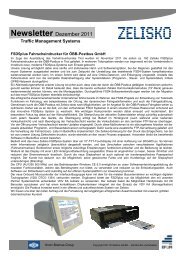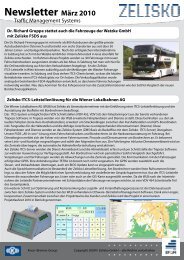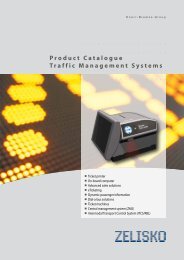Annual Report 2012 - Knorr-Bremse AG.
Annual Report 2012 - Knorr-Bremse AG.
Annual Report 2012 - Knorr-Bremse AG.
Create successful ePaper yourself
Turn your PDF publications into a flip-book with our unique Google optimized e-Paper software.
70 <strong>Report</strong> ProduCts // Commercial vehicle systems<br />
The N2G has been designed to be more robust than its predecessor. <strong>Knorr</strong>-<strong>Bremse</strong> has also transferred<br />
the entire assembly process to its Aldersbach plant, where it has developed a separate assembly<br />
line and appropriate test rigs. And all the components needed for the assembly of the N2G adjuster<br />
are now being sourced directly from the suppliers by <strong>Knorr</strong>-<strong>Bremse</strong>.<br />
The new short spring<br />
brake takes account<br />
of the ever smaller<br />
installation envelopes<br />
at the wheelend.<br />
Short NG3 spring brake added to portfolio<br />
<strong>Knorr</strong>-<strong>Bremse</strong> has added the Short NG3 spring brake to its portfolio. As the name suggests, this is an<br />
extra-short spring brake measuring just 204 mm. While it can be customized for any brake application<br />
and output force requirement, the new spring brake was primarily designed for use on the front<br />
axle. With its reduced length and the resultant drop in weight, it takes account of the ever smaller<br />
installation envelopes at the wheelend – that is hub, bearings and brake disc. The improved location<br />
of its center of gravity means that the Short NG3 will also offer high vibration resistance.<br />
In the year under review, initial prototypes were produced at <strong>Knorr</strong>-<strong>Bremse</strong> and the first tests conducted<br />
together with a customer. The target for volume production is the end of 2015.<br />
<strong>Knorr</strong>-<strong>Bremse</strong> KAMA further develops drum brake<br />
Disc brakes predominate in the Western European truck market, but there is still comparatively strong<br />
demand for drum brakes in Eastern Europe, Russia, North and South America and Asia. This has both<br />
historical and practical reasons. Drum brakes are relatively enclosed, which means the surfaces of the<br />
brake pads and drums are well protected from corrosion and dirt when the vehicle is operating in<br />
rough terrain.<br />
<strong>Knorr</strong>-<strong>Bremse</strong> currently manufactures a tried-and-tested drum brake in Russia in a joint venture set up<br />
in 2007 with Russian vehicle manufacturer KAMAZ, but in the medium and longer term the plan is to<br />
develop an entirely new concept for the next generation.<br />
In the year under review the joint venture – with the support of <strong>Knorr</strong>-<strong>Bremse</strong>’s subsidiary Bendix<br />
Spicer – started work on optimizing the existing brake, with the aim of improving its functionality,<br />
reducing its weight and introducing modern technologies for its production. A further requirement<br />
was that the modified brake should be easier to install. Most of the development work on the new<br />
brake is being carried out by <strong>Knorr</strong>-<strong>Bremse</strong> KAMA, the Russian joint venture, but the product is destined<br />
to be sold in all markets worldwide.<br />
Volume production of Pneumatic Booster System PBS<br />
<strong>Knorr</strong>-<strong>Bremse</strong>’s Pneumatic Booster System (PBS) eliminates so-called turbo-lag in commercial vehicle diesel<br />
engines during drive-off. It boosts engine performance and also enables down-speeding or down-sizing,<br />
which saves fuel. In <strong>2012</strong> a major customer started to install the system as standard equipment.<br />
Several seconds can pass before a large turbo-diesel engine reaches maximum torque. PBS briefly<br />
boosts the engine’s power output by blowing compressed air from the braking system into the engine<br />
air intake, effectively overcoming the turbo-lag that can occur during drive-off, overtaking or on uphill<br />
gradients. The engine responds more rapidly, and as the vehicle accelerates, the driver can select a<br />
higher gear earlier. This reduces average engine revs – which can result in fuel savings of up to 5%.<br />
A vehicle equipped with PBS accelerates as though it had an engine with 20% to 30% more cubic<br />
capacity, which means that a smaller engine equipped with PBS can replace a larger one. Particularly<br />
in the case of local public transport and freight distribution operations this is a considerable advantage,<br />
as less installation space is required for the engine.



![1 Newsletter 2013 Version 0 92 [Kompatibilitätsmodus] - Zelisko](https://img.yumpu.com/50939577/1/184x260/1-newsletter-2013-version-0-92-kompatibilitaatsmodus-zelisko.jpg?quality=85)




![Backofficelösung ZMS [PDF, 740 kB] - Zelisko](https://img.yumpu.com/33964695/1/184x260/backofficelaasung-zms-pdf-740-kb-zelisko.jpg?quality=85)

![Geschäftsbericht 2012 [PDF, 13 MB] - Zelisko](https://img.yumpu.com/31517535/1/184x260/geschaaftsbericht-2012-pdf-13-mb-zelisko.jpg?quality=85)


![Produktkatalog Gesamtlösungen [PDF, 4 MB] - Zelisko](https://img.yumpu.com/22973479/1/182x260/produktkatalog-gesamtlaasungen-pdf-4-mb-zelisko.jpg?quality=85)
![ITCS Datenblatt [PDF, 804 kB] - Zelisko](https://img.yumpu.com/22855155/1/184x260/itcs-datenblatt-pdf-804-kb-zelisko.jpg?quality=85)
![Fahrscheindrucker FSD5plus [PDF, 934 kB] - Zelisko](https://img.yumpu.com/22822643/1/184x260/fahrscheindrucker-fsd5plus-pdf-934-kb-zelisko.jpg?quality=85)
